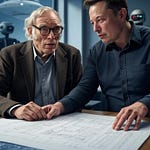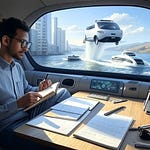Imagine a world where flying is as natural and free as driving a car. A world where, instead of filing a flight plan and waiting for permissions, you simply board an aerial vehicle and take off whenever you want, wherever you can, within a system that guides you without suffocating you. This is not a distant fantasy but a possibility within our grasp thanks to technological advancements. In this article, we will explore why we need to eliminate flight plans and embrace freedom in the air, drawing inspiration from the same autonomy we already enjoy on the roads.
Why freedom on the road, but not in the air?
When I think about how we use cars, an inevitable question arises: why do we have so much freedom on the road and so little in the airspace? When driving, we join the network of streets, highways, and paved roads, choose our route, and reach our destination without asking anyone’s permission. Of course, there are traffic rules—traffic lights, signs, speed limits—but within that framework, we are free to move in the horizontal plane. This freedom has transformed our lives, giving us flexibility and control over our time and space.
Now, let’s look at the sky. Every time an airplane, whether commercial or private, wants to take off, it must file a detailed flight plan, obtain approval from air traffic control authorities, and follow strict routes under constant supervision. This system, designed to ensure safety, has worked well in a world of traditional airplanes and human pilots. But what if we could do better? What if the air could be as accessible as the road?
The dawn of eVTOLs and autonomous navigation
We are entering an exciting era with eVTOLs (electric vertical take-off and landing vehicles). Companies like EHang in China, Xpeng, Archer in the United States, and Lilium in Germany are developing machines that can take off from a rooftop, fly to your destination, and land without the need for airports. These are not futuristic dreams; they are real prototypes already flying in tests.
However, there is an obstacle: even these revolutionary vehicles are bound by the same rigid rules of flight plans. If we want to unlock their true potential, we need a radical change. This is where autonomous navigation comes in. Flying is complex for a human—it requires years of training to become a pilot—but for a machine with artificial intelligence, advanced sensors, and real-time communication, it is a much more manageable challenge.
Let’s think about autonomous cars. We are close to achieving Level 5 autonomy on the road, where vehicles like Tesla’s Robotaxi will be able to drive without human intervention, navigating the chaos of cities with precision. If we can trust machines to handle ground traffic, why not aerial traffic? In fact, the three-dimensional space might be even simpler: there are no pedestrians, traffic lights, or unexpected obstacles. Autonomous eVTOLs could coordinate with each other, dynamically adjusting routes and avoiding collisions without the need for constant centralized control.
Overcoming fear: safety in a free sky
I know what you’re thinking: “What if something goes wrong? What if an eVTOL crashes or collides in the air?” It’s an understandable fear, but it’s not a new problem. When cars became popular over a century ago, people were also afraid. What if those fast, heavy objects ran over someone or crashed into each other? However, we didn’t ban cars or limit them to fixed routes. Instead, we improved technology—brakes, seat belts, airbags—and built infrastructure like signs and lanes. Over time, driving became safer and more accessible.
With eVTOLs, we can apply the same logic, but with an advantage: current technology is much more advanced. Autonomous systems don’t get tired, don’t get distracted, and react in milliseconds. They can communicate with other vehicles and follow strict safety protocols. Additionally, by flying at low altitudes and within predefined aerial corridors—like “highways in the sky”—we reduce risks. An eVTOL that fails doesn’t have to be a catastrophe; it can make an emergency landing in a designated area, minimizing the impact.
How it would work: a system of structured freedom
So, what would this aerial freedom look like in practice? It’s not about me, from my apartment in the Bronx, hopping on an eVTOL and flying to Brooklyn wherever I please, risking a collision with another vehicle. The key is a system that combines freedom with order, just like on the roads.
Imagine aerial corridors—established routes in the sky, like invisible highways—where eVTOLs can move freely. These vehicles, guided by autonomous systems, would coordinate in real-time with others on the network, maintaining safe distances and optimizing trajectories. You wouldn’t need to file a flight plan or wait for approval; you would simply tell your eVTOL where you want to go, and it would take you via the most efficient route within the system. It’s the same logic we use when driving, but in three dimensions.
The grand prize: a transformed world
Eliminating flight plans and granting freedom to the airspace is not just a matter of convenience; it’s a revolution. You could cross the city in minutes, avoiding ground traffic. Rural areas would connect with urban ones like never before. Cities could be redesigned, with buildings integrating “vertiports” and new economic opportunities flourishing in the air.
But beyond the practical, there is something deeply inspiring about this. As humans, we have always dreamed of flying, of conquering the sky. Now, with eVTOLs and autonomy, we can make that dream a reality for everyone, not just a privileged few. It’s a step forward in our history of progress, a leap that unlocks the immense value of aerial transportation.
Conclusion: the sky is ours to take
The future is not in maintaining the chains of the past, like mandatory flight plans. It’s in trusting technology to open up the airspace for us, just as cars opened up the roads. With autonomous eVTOLs, we can fly whenever we want, wherever we can, within a system that protects us without limiting us.
This is not reckless; it’s optimism based on facts. It’s the spirit of human progress—the same that took us from carts to automobiles—now taking us to the skies. Removing the flight plan is not just a technical idea; it’s a declaration of freedom. And that freedom is ready to take off.













Share this post